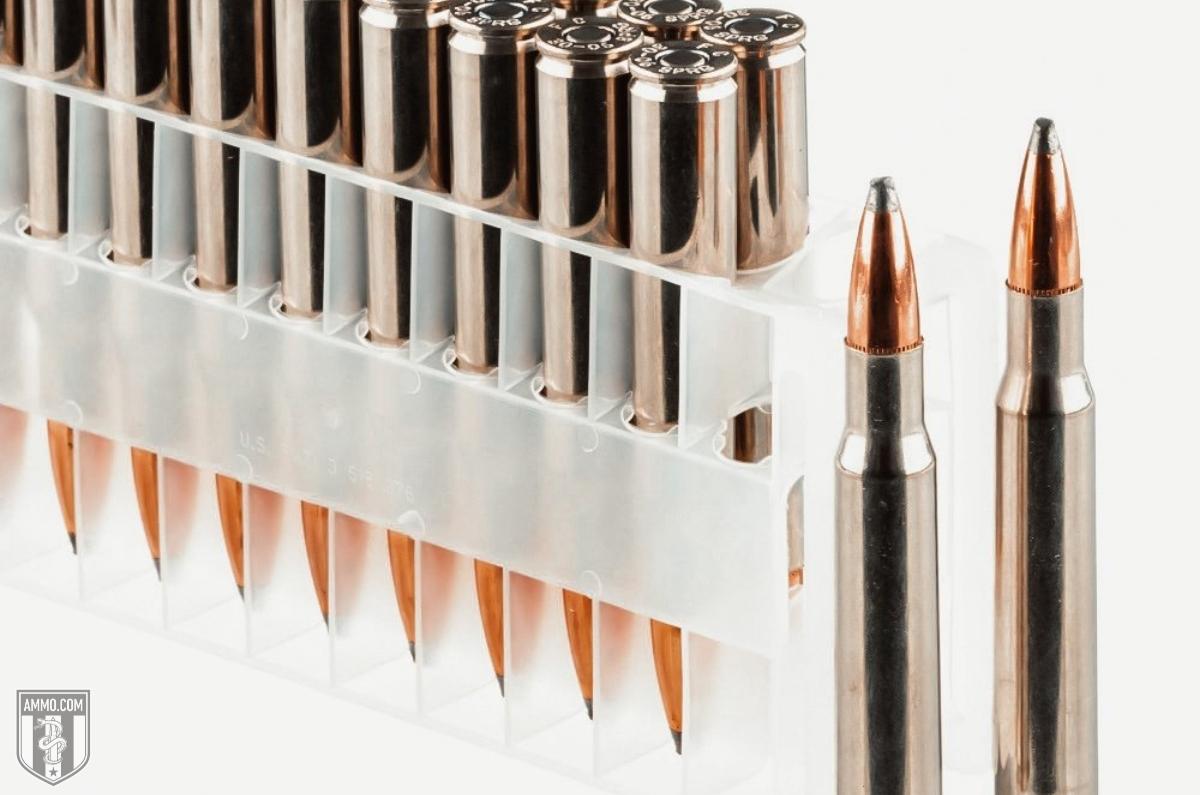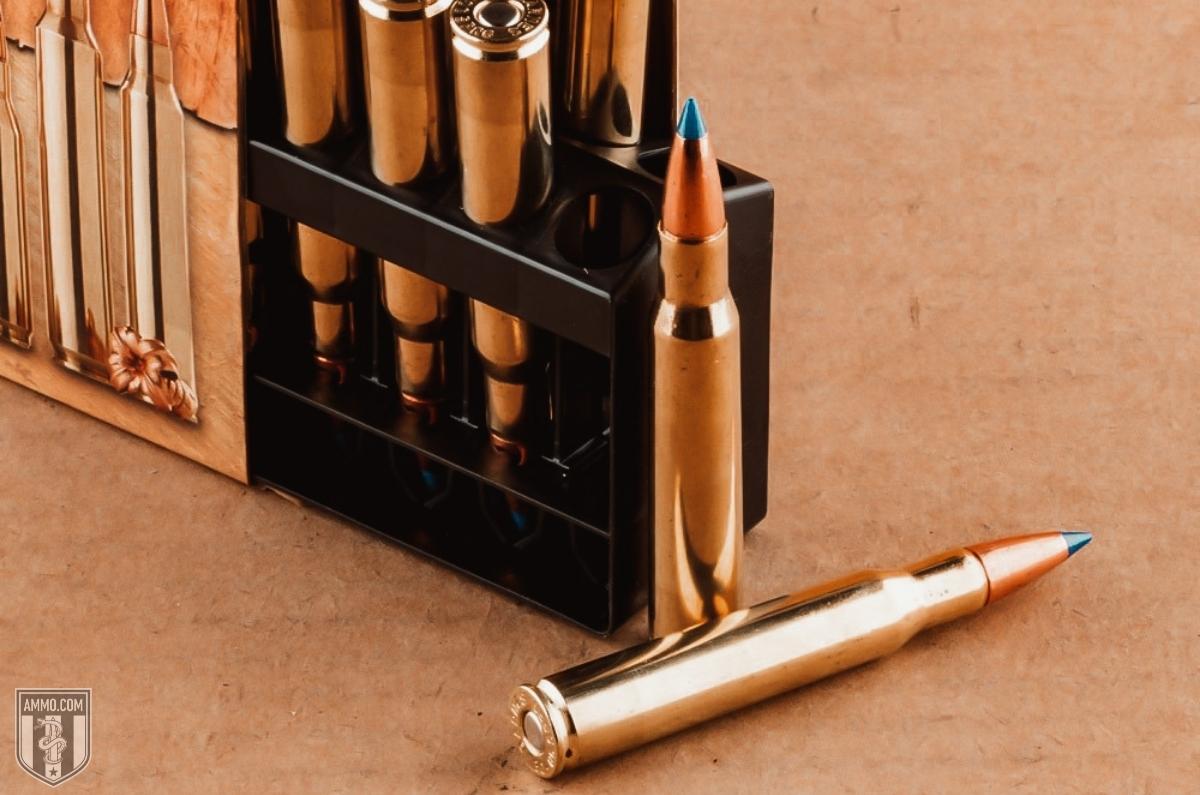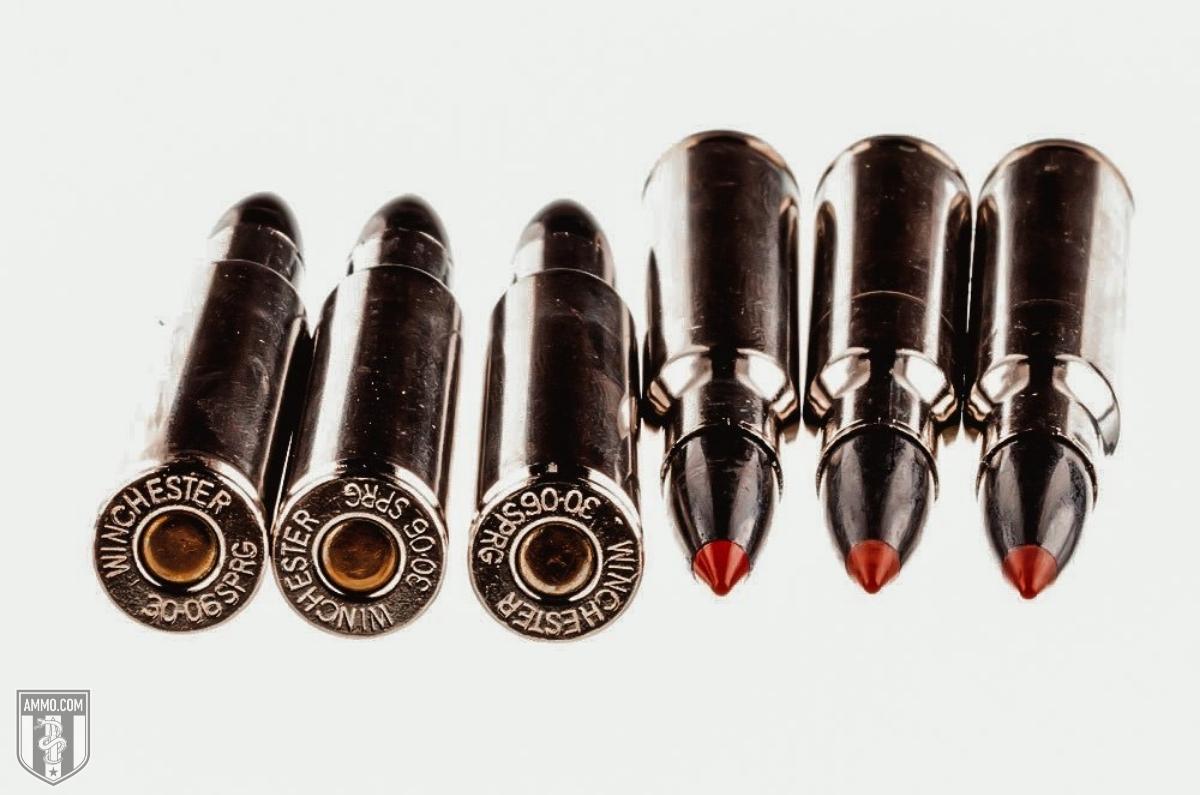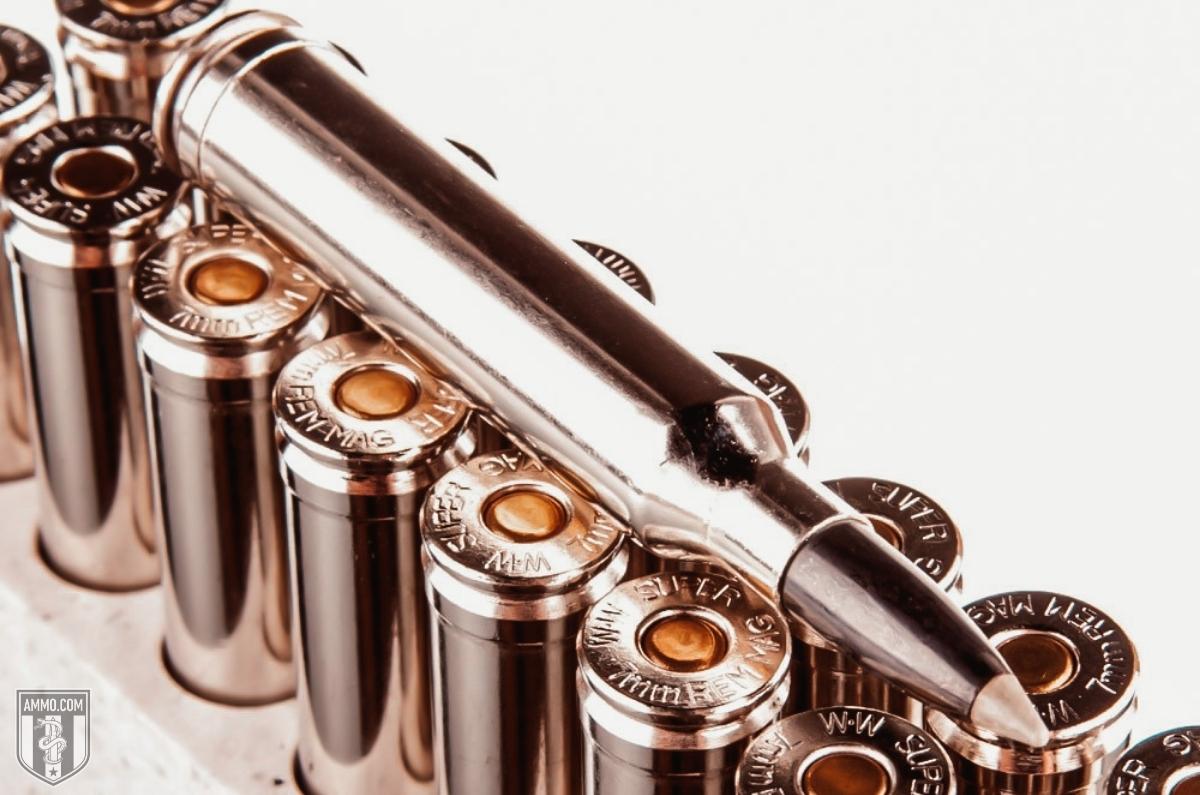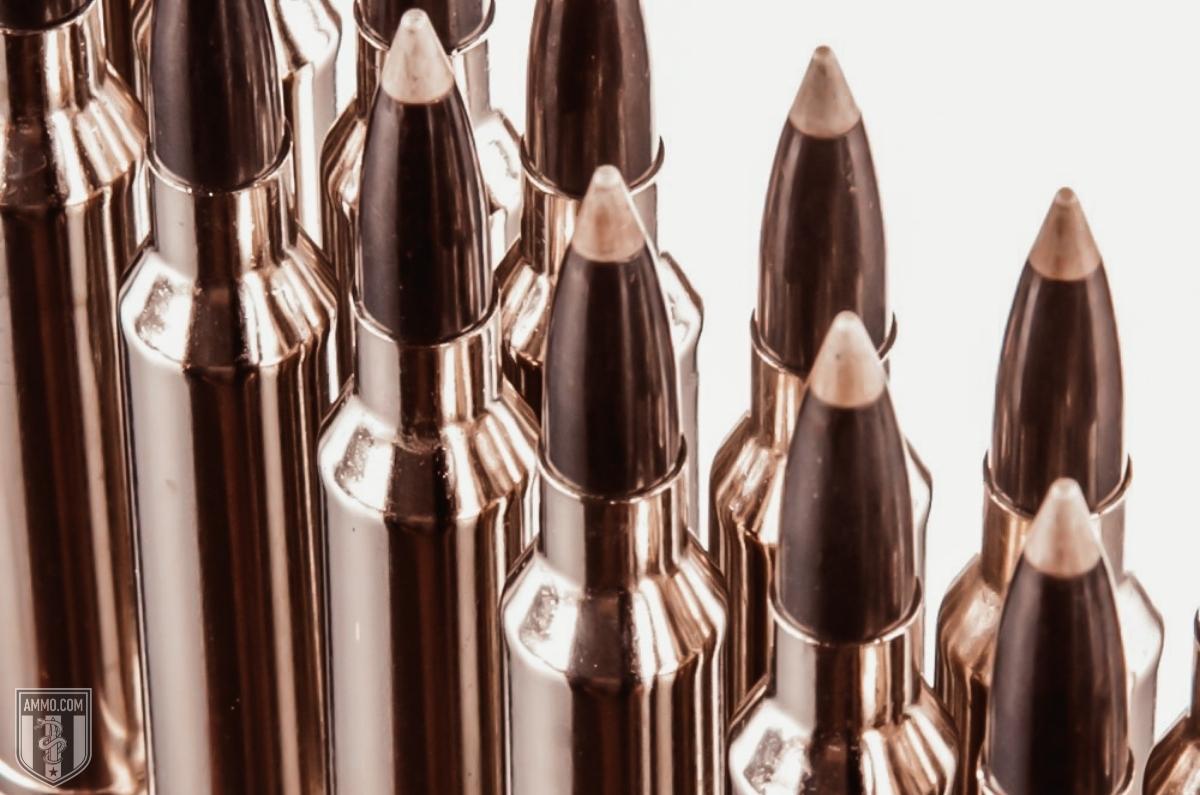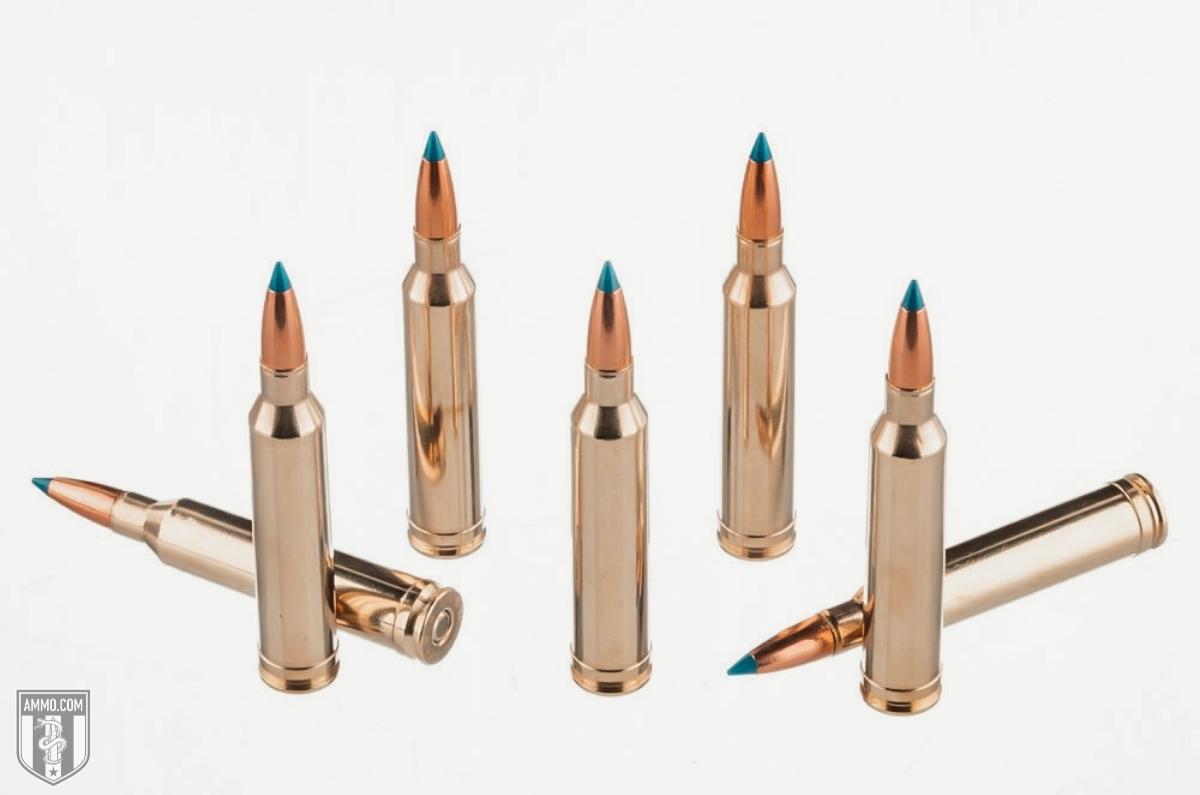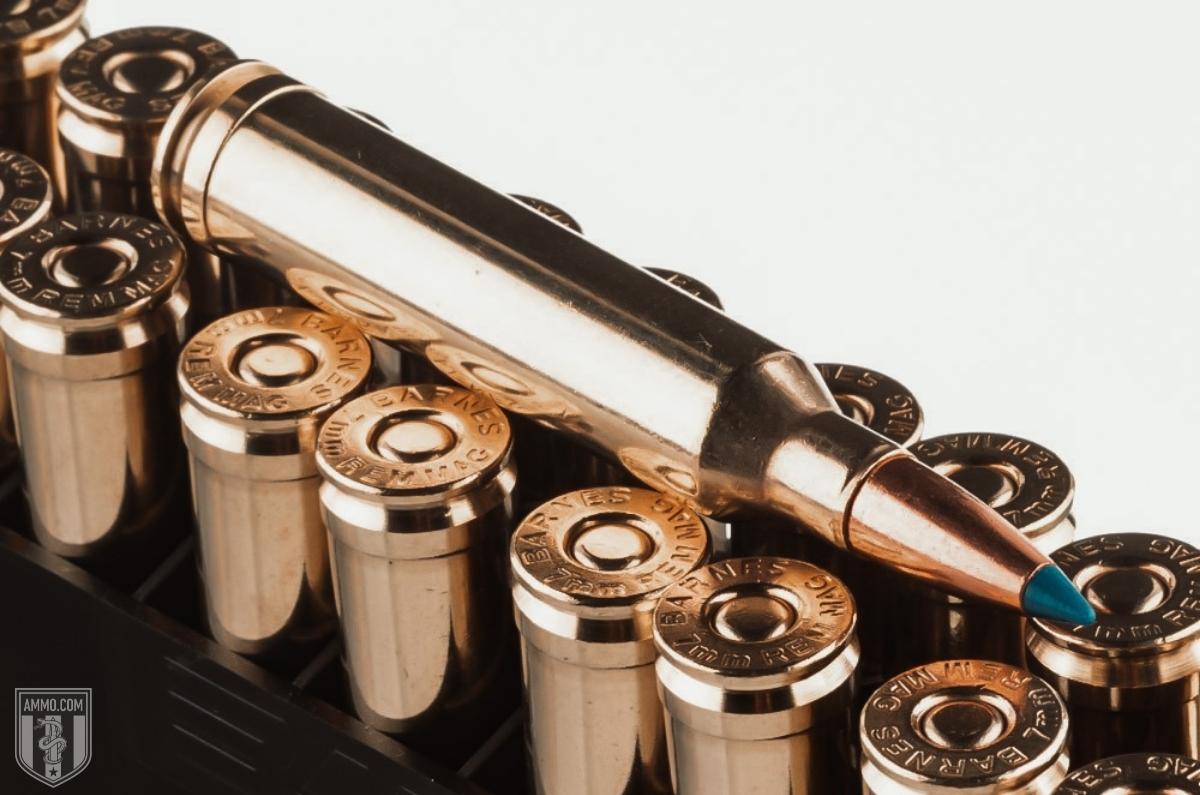30-06 vs 7mm Rem Mag: To Magnum or Not to Magnum?
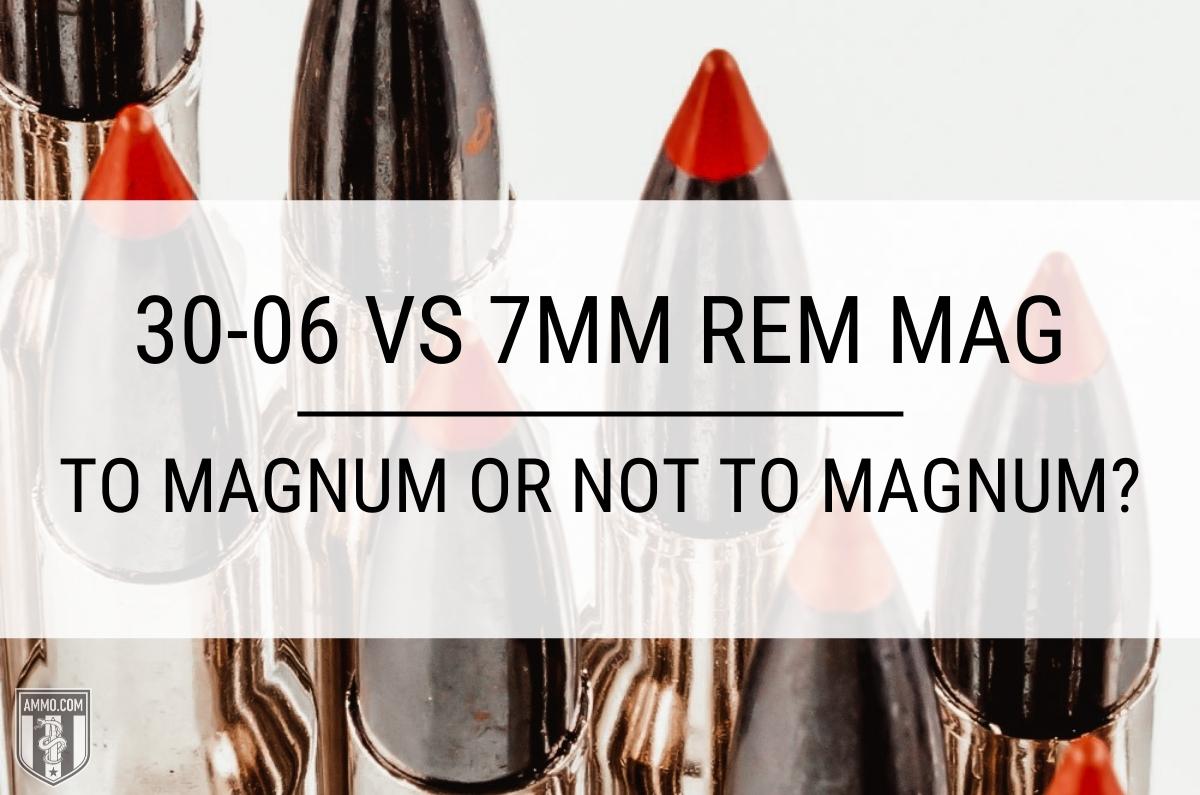 As Hamlet the Hunter lifted his deer skull trophy towards the heavens, he posed this missive to the universe, “To magnum or not to magnum? This is the question!”
As Hamlet the Hunter lifted his deer skull trophy towards the heavens, he posed this missive to the universe, “To magnum or not to magnum? This is the question!”
When it comes to terminal performance on medium to big game animals, it is hard to beat the effectiveness of the 30-06 Springfield and the 7mm Remington Magnum.
Both are extremely popular with sportsmen across North America and make an excellent choice for your new hunting rifle.
However, there has been exhaustive debate at gun counters, campfires, and online forums as to which of these two hunting cartridges is superior.
It’s a debate of hair-splitting details and truly comes down to your preference as a hunter or long-range shooter.
In this article, we will break down the advantages and disadvantages of each rifle cartridge to help you make an informed decision on your next hunting rifle purchase.
What is the Difference Between 30-06 and a 7mm?
The 30-06 Springfield has been one of the most popular rifle cartridges across North America since its introduction in 1906 and is the gold standard by which all other hunting cartridges are measured. One does not need to look far on any online gun forums to see retorts like, “But is it better than a 30-06?”
As the US military’s primary rifle cartridge for WWI, WWII, and the Korean War, the 30-06 has proven its effectiveness against 2-legged and 4-legged varmints across 6 continents and over a century of service to soldiers and sportsmen alike.
The 7mm Remington Magnum was Remington’s addition to the belted magnum craze of the 1960s and was specifically designed as a sporting cartridge. Due to its design, the 7mm can fire the same popular bullet weights as the 30-06, but it does so with higher FPS at the muzzle, more ft-lbs of energy, and can retain those ballistic advantages at longer ranges.
From a bird’s eye view, it seems as though the 7mm Rem Mag outperforms the 30-06 in virtually every ballistic category, but why then does the 30-06 remain one of the most popular sporting cartridges on the market?
In the following sections, we will thoroughly examine the differences between these two cartridges and explain why some hunters prefer the old 30-06 warhorse over the ballistically superior 7mm Rem Mag.
Cartridge Specs
When evaluating two big game hunting cartridges, it’s a good idea to analyze the cartridge specs to gain more knowledge of each.
The first, and most obvious difference, is that each cartridge fires a different caliber bullet. The 30-06, as you might guess, fires 30-caliber or 0.308” diameter bullets while the 7mm Rem Mag fires 0.284” diameter bullets (7.2mm).
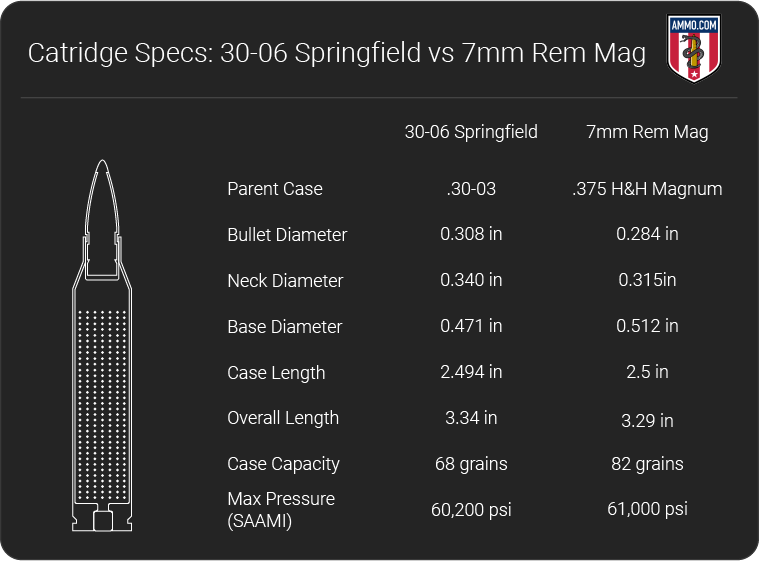
While the case length for the 30-06 is only 0.006” shorter than the 7mm, the case capacity is quite different between the two. The 30-06 can accommodate a respectful 68 grains of powder while the 7mm Rem Mag is packing a massive 82 grains of case capacity.
This difference in case capacity is due to the 7mm RM being a wider cartridge with a 0.512” base diameter. This wider base requires the use of a magnum bolt face, however, the overall length of the 7mm is 0.05” shorter than the 30-06, which means the 7mm Rem Mag can fit in a standard action receiver.
The 7mm Remington Magnum can also accommodate slightly higher SAAMI max pressures at 61,000 psi compared to 60,200 psi for the 30-06
Recoil
Recoil is the energy directed towards the shooter when a cartridge is fired from a firearm. For experienced hunters or marksmen, recoil will be a non-issue. However, for less experienced shooters or those who are recoil sensitive, less recoil will be preferred.
Lower recoil will also allow shooters to get their sights back on target quicker for follow-up shots. In contrast, heavy recoil can cause shooters to flinch before they pull the trigger, and during long-range shooting sessions, shoulder fatigue can become an issue.
On average, the 7mm Rem Mag will have about 28 ft-lbs of felt recoil, while the 30-06 will have less recoil with an average of 23 ft-lbs.
In terms of real-world experience, this is not a significant difference and the added recoil of the 7mm can easily be mitigated by using a muzzle brake or a recoil pad. Generally speaking, the 7mm RM is a fairly light recoiling magnum round when compared to the 300 Win Mag or the 300 WSM.
The 30-06 will generally have less recoil than the 7mm Rem Mag.
Trajectory
Trajectory is how we quantify a bullet’s flight path as it travels downrange measured in inches of bullet drop.
Having a flat shooting cartridge is preferred for shooting longer ranges as a shooter will have to make fewer adjustments to their optics to compensate for bullet drop. Having a flatter trajectory also means that a cartridge will be more forgiving of ranging mistakes.
At shorter ranges (under 400 yards), both rifle cartridges have virtually identical trajectories. However, once you start shooting 400-1,000 yards, the difference in trajectory becomes apparent.
At 500 yards, the 30-06 has experienced an average of -48” of bullet drop while the 7mm Rem Mag has dropped -38”. Some proponents of the 30-06 might contest that 10” isn’t all that much, but that could easily be the difference between a double-lung shot and grazing the belly of the prize whitetail or mule deer you’ve been staling all day.
At 1,000 yards the flat shooting 7mm RM really shines, as it has dropped -287” compared to -398” for the 30-06 Springfield.
For long-range shooting, the 7mm Remington Magnum clearly has a flatter trajectory and is the superior choice.
Ballistic Coefficient
Ballistic coefficient (BC) is a measure of how well a bullet resists wind drift and air resistance. Put another way, it’s a numeric representation of how aerodynamic a bullet is. A high BC is preferred as this means the bullet will buck the wind easier.
Generally, heavier bullets will have a higher BC as it takes more force to disrupt the flight of a heavier bullet than a lighter one.
Ballistic coefficient varies from bullet to bullet based on design, weight, and other factors that are beyond the scope of this article.
However, the 7mm Rem Mag generally will have a slight edge over the 30-06 in terms of BC. Several excellent offerings in 7mm RM would be the Hornady Superformance 162 gr, having a BC of 0.55, and the Berger Trophy Gold VLD 168 gr, with a BC of 0.618.
Some top performers for the 30-06 include the Nosler AccuBond 200 gr with a BC of 0.50 and the Federal Gold Medal Match 168 gr at 0.463.
This does not detract from the 30-06 in any way, as anything with a BC over 0.40 is considered very good. However, the 7mm RM is just better in terms of ballistic coefficient as it can fire the more slender, aerodynamic bullets at higher muzzle velocity which aids in resisting wind drift.
Sectional Density
Sectional Density (SD) is the measure of how well a bullet penetrates a target. This is extremely important when hunting big game, as you need a bullet that can punch through thick hide, bone, and sinew.
Sectional density is calculated by comparing the bullet weight and the bullet diameter. The higher the SD the deeper the bullet will penetrate the target.
This is a simplified view of penetration as there are other factors to consider, such as bullet expansion and velocity.
The 200 gr Nosler Accubond for the 30-06 continues to perform extremely well and has a SD of 0.301, while the Winchester Expedition Big Game 168 gr 7mm RM has a SD of 0.298.
Although there can be variation in SD between bullet weights and design, there is not a significant difference in sectional density between 7mm and 30-06. And it is extremely unlikely that a hunter, whitetail, antelope, or mule deer will be able to detect any noticeable difference between the two.
Hunting
When comparing rifle cartridges for your next hunting rifle, it’s important to look at all the different variables between the two.
The 30-06 shoots larger diameter bullets with about 18% more frontal surface area than the 7mm, meaning the 30-06 will create a larger permanent wound channel. However, the 7mm Rem Mag will have slightly higher muzzle velocity and retain its kinetic energy more efficiently over longer ranges.
Furthermore, the 7mm will generally have a flatter trajectory and resist wind drift better than similarly weighted bullets fired from the 30-06, though the 30-06 will have a lower recoil impulse. Slightly higher sectional density ratings also help the 7mm Rem Mag hit above its weight class like the 7x57mm Mauser or 270 Winchester.
Both hunting cartridges are extremely versatile, with lightweight bullets for varmints to heavyweight options for elk and bears.
Many internet hunting forums are ablaze with controversy over which of these rifle cartridges are superior. But the truth is that we are simply splitting hairs here.
In any real-world hunting scenario at ethical ranges, there’s no deer, elk, moose, or bear across North America that will be able to tell the difference between the 30-06 and the 7mm Rem Mag. So long as your shot placement is on point, both cartridges will serve you well.
Ammo/Rifle Cost and Availability
In terms of rifle availability, both the 30-06 and 7mm Remington Magnum have a multitude of options available. Most models are bolt-action rifles as hunters and marksmen aim for high levels of accuracy with both cartridges.
Some popular hunting rifles include:
- Savage 110 Hunter
- Winchester Model 70
- Tikka T3
- Remington 700
- Weatherby Vanguard
In terms of semi-auto rifles, the Browning BAR is available in both calibers, however, the venerable M1 Garand is also an option for 30-06.
If you’re looking for a hunting rifle with some character, you might enjoy a military surplus rifle. The 30-06 has several surplus options, such as the 1903 Springfield and rebarreled Mauser rifles, which are relatively easy to come by on the secondary market.
In terms of rifle cost, new production rifles for 30-06 and 7mm RM will be essentially identical. Surplus military rifles will generally be less expensive, but it’s getting harder and harder to get your hands on a reasonably priced CMP field grade M1 Garand.
One other consideration is rifle weight and barrel length. One downside of the 7mm RM is that it requires nothing less than a 24-26” barrel to reach its full potential as a cartridge, while the 30-06 can perform at peak levels using a 22” barrel. A shorter barrel will be more maneuverable in heavy brush and will also weigh less, making it easier to carry on long stalks or hikes.
In general, a 30-06 hunting rifle will be lighter and shorter than its 7mm Rem Mag counterpart, giving the 30-06 a slight edge in this category.
In terms of factory loads, it’s hard to beat the variety of ammo offered for 30-06. Since it was a military round for multiple decades, there have been extensive advancements and developments surrounding America’s iconic 30-caliber rifle cartridge.
The 7mm is not lacking in options by any stretch of the imagination, there are just simply more for 30-06.
The 30-06’s popularity also lead to lower cost per round as cheap practice ammo can be had for as low as $1.30/round while premium hunting ammo, like Barnes VOR-TX, will cost upwards of $3.00/round.
Speaking of ammo price make sure to check out our stock of Hornady 30-06 ammo and Remington .30-06 ammo for more options.
Although not as common, ammo for 7mm Rem Mag is not prohibitively expensive. Practice ammo typically runs around $1.70/round and premium hunting rounds, like Sierra GameChanger or Federal Premium Terminal Ascent 7mm Rem Mag ammo, will hit your wallet for about $4/round.
Every gun shop and sporting goods store across North America will have 30-06 ammo on the shelves. And although the 7mm Rem Mag is still a popular cartridge, it might be difficult to find factory loads in smaller stores as it is less popular than the 30-06.
Reloading
One way to reduce your overall cost per round is to handload your own ammo. This allows you to customize your ammo to match your rifle, creating extremely accurate and consistent rounds.
In terms of reloading the 30-06, it is perhaps one of the most frequently handloaded cartridges on the North American continent. There is a plethora of different bullet weights and profiles available from all the major bullet manufacturers like Sierra, Hornady, Barnes, Berger, and Nosler.
The 0.308” diameter bullet is extremely popular and is used for reloading 308 Winchester, 300 Win Mag, and 300 WSM, just to name a few.
One tricky aspect of reloading 7mm Rem Mag is recognizing that it doesn’t fire a true 7mm bullet. The bullet diameter for 7mm RM is 0.284” or 7.2mm, and this limits the cartridges that share bullet cross-compatibility. Those cartridges that fire a 0.284” diameter bullets include the 280 Remington, 7mm-08, 7mm WSM, 7mm Weatherby Magnum, and the .284 Winchester.
Although less popular, all the major bullet manufacturers will have offerings for 0.284” diameter bullets, just not as many as for 30-caliber.
Ballistics
Our team here at Ammo.com has spent countless hours scouring the Internet to bring you extremely comprehensive ballistics tables for both calibers. These tables will compare bullet weight to muzzle velocity, muzzle energy, and trajectory.
7mm Remington Magnum Ballistics
Note: This information comes from the manufacturer and is for informational purposes only. The actual ballistics obtained with your firearm can vary considerably from the advertised ballistics. Also, ballistics can vary from lot to lot with the same brand and type load.
| 7mm Remington Magnum Bullet WEIGHT | Muzzle VELOCITY (fps) | Muzzle ENERGY (ft. lbs.) | TRAJECTORY (in.) | |||||||||||
|---|---|---|---|---|---|---|---|---|---|---|---|---|---|---|
| Muzzle | 100 yds. | 200 yds. | 300 yds. | 400 yds. | Muzzle | 100 yds. | 200 yds. | 300 yds. | 400 yds. | 100 yds. | 200 yds. | 300 yds. | 400 yds. | |
| 139 Grain | 3190 | 2986 | 2791 | 2605 | 2427 | 3141 | 2752 | 2405 | 2095 | 1817 | 1.2 | 0 | -5.7 | -16.5 |
| 139 Grain | 3150 | 2930 | 2710 | 2510 | 2320 | 3085 | 2660 | 2290 | 1960 | 1670 | 2.5 | 2.4 | -2.4 | -12.7 |
| 139 Grain Superformance | 3240 | 3033 | 2836 | 2648 | 2467 | 3239 | 2839 | 2482 | 2163 | 1877 | 1.1 | 0 | -5.5 | -15.9 |
| 140 Grain | 2710 | 2482 | 2265 | 2059 | n/a | 2283 | 1915 | 1595 | 1318 | n/a | 0 | -4.5 | -1.57 | 0 |
| 140 Grain | 3150 | 2930 | 2710 | 2510 | 2320 | 3085 | 2660 | 2290 | 1960 | 1670 | 2.5 | 2.4 | -2.4 | -12.7 |
| 140 Grain BR | 2216 | 2012 | 1821 | 1643 | 1481 | 1525 | 1259 | 1031 | 839 | 681 | 2 | -3.7 | -20 | 0 |
| 140 Grain SA ULTRA MAG | 3175 | 2934 | 2707 | 2490 | 2283 | 3033 | 2676 | 2277 | 1927 | 1620 | 1.3 | 0 | -6 | -17.7 |
| 140 Grain Ultra | 3425 | 3184 | 2956 | 2740 | 2534 | 3646 | 3151 | 2715 | 2333 | 1995 | 1.7 | 1.6 | -2.6 | -11.4 |
| 150 Grain | 3110 | 2830 | 2568 | 2320 | 2085 | 3221 | 2667 | 2196 | 1792 | 1448 | 2.5 | 1.6 | -4.6 | -16.5 |
| 150 Grain SA ULTRA MAG | 3110 | 2828 | 2563 | 2313 | 2077 | 3221 | 2663 | 2188 | 1782 | 1437 | 2.5 | 2.1 | -3.6 | -15.8 |
| 154 Grain | 3110 | 2830 | 2568 | 2320 | 2085 | 3221 | 2667 | 2196 | 1792 | 1448 | 2.5 | 1.6 | -4.6 | -16.5 |
| 154 Grain Superformance | 3100 | 2914 | 2736 | 2565 | 2401 | 3286 | 2904 | 2560 | 2250 | 1970 | 1.3 | 0 | -5.9 | -17.2 |
| 160 Grain | 2950 | 2730 | 2520 | 2320 | 2120 | 3090 | 2650 | 2250 | 1910 | 1600 | 2.5 | 1.8 | -4.4 | -17.8 |
| 160 Grain SA ULTRA MAG | 2850 | 2676 | 2508 | 2347 | 2192 | 2885 | 2543 | 2235 | 1957 | 1706 | 1.7 | 0 | -7.2 | -20.7 |
| 160 Grain SA ULTRA MAG | 2960 | 2762 | 2572 | 2390 | 2215 | 3112 | 2709 | 2350 | 2029 | 1743 | 2.6 | 2.2 | -3.6 | -15.4 |
| 160 Grain Ultra | 3225 | 3035 | 2854 | 2680 | 2512 | 3694 | 3273 | 2894 | 2551 | 2242 | 0 | -2.3 | -8.8 | -20.2 |
| 162 Grain | 2950 | 2730 | 2520 | 2320 | 2120 | 3090 | 2650 | 2250 | 1910 | 1600 | 2.5 | 1.8 | -4.4 | -17.8 |
| 165 Grain | 2900 | 2699 | 2507 | 2324 | 2147 | 3081 | 2669 | 2303 | 1978 | 1689 | 2.5 | 1.2 | -5.9 | -19 |
| 174 Grain Ultra | 3040 | 2896 | 2756 | 2621 | 2490 | 3590 | 3258 | 2952 | 2669 | 2409 | 0 | -2.6 | -9.9 | -22.2 |
| 175 Grain | 2860 | 2645 | 2440 | 2244 | 2057 | 3178 | 2718 | 2313 | 1956 | 1644 | 2.5 | 1 | -6.5 | -20.7 |
.30-06 Ballistics
Note: This information comes from the manufacturer and is for informational purposes only. The actual ballistics obtained with your firearm can vary considerably from the advertised ballistics. Also, ballistics can vary from lot to lot with the same brand and type load.
| 30-06 Bullet WEIGHT | Muzzle VELOCITY (fps) | Muzzle ENERGY (ft. lbs.) | TRAJECTORY (in.) | |||||||||||
|---|---|---|---|---|---|---|---|---|---|---|---|---|---|---|
| Muzzle | 100 yds. | 200 yds. | 300 yds. | 400 yds. | Muzzle | 100 yds. | 200 yds. | 300 yds. | 400 yds. | 100 yds. | 200 yds. | 300 yds. | 400 yds. | |
| 55 Grain | 4080 | 3485 | 2965 | 2502 | 2083 | 2033 | 1483 | 1074 | 764 | 530 | 2 | 1.9 | -2.1 | -11.7 |
| 125 Grain | 2660 | 2335 | 2034 | 1757 | n/a | 1964 | 1513 | 1148 | 856 | n/a | 0 | -5.2 | -18.9 | 0 |
| 125 Grain | 2700 | 2412 | 2143 | 1891 | 1660 | 2023 | 1615 | 1274 | 993 | 765 | 2.3 | 0 | -9.9 | -29.5 |
| 125 Grain | 3140 | 2780 | 2447 | 2138 | 1853 | 2736 | 2145 | 1662 | 1279 | 953 | 2 | 1 | -6.2 | -21 |
| 150 Grain | 2910 | 2617 | 2342 | 2083 | 1853 | 2820 | 2281 | 1827 | 1445 | 1135 | 2.5 | 0.8 | -7.2 | -23.4 |
| 150 Grain | 3080 | 2848 | 2617 | 2417 | 2216 | 3159 | 2700 | 2298 | 1945 | 1636 | 1.4 | 0 | -6.4 | -18.9 |
| 165 Grain | 2800 | 2534 | 2283 | 2047 | 1825 | 2872 | 2352 | 1909 | 1534 | 1220 | 2.5 | 0.4 | -8.4 | -25.5 |
| 168 Grain | 2710 | 2522 | 2346 | 2169 | 2003 | 2739 | 2372 | 2045 | 1754 | 1497 | 2.5 | 0.4 | -8 | -23.5 |
| 168 Grain M1 Garand | 2710 | 2523 | 2343 | 2171 | 2006 | 2739 | 2374 | 2048 | 1758 | 1501 | 2.3 | 0 | -8.6 | -24.6 |
| 170 Grain | 2000 | 1740 | 1510 | n/a | n/a | 1510 | 1145 | 860 | n/a | n/a | 0 | 0 | 0 | 0 |
| 178 Grain | 2720 | 2511 | 2311 | 2121 | 1939 | 2924 | 2491 | 2111 | 1777 | 1486 | 2.5 | 0.4 | -8.2 | -24.6 |
| 180 Grain | 2700 | 2469 | 2250 | 2042 | 1846 | 2913 | 2436 | 2023 | 1666 | 1362 | -2.5 | 0 | -9.3 | -27 |
| 180 Grain Superformance | 2820 | 2630 | 2447 | 2272 | 2104 | 3178 | 2764 | 2393 | 2063 | 1769 | 1.8 | 0 | -7.6 | -21.9 |
| 180 Grain High Energy | 2880 | 2690 | 2500 | 2320 | 2150 | 3315 | 2880 | 2495 | 2150 | 1845 | 1.7 | 0 | -7.2 | -21 |
| 220 Grain | 2410 | 2130 | 1870 | 1632 | 1422 | 2837 | 2216 | 1708 | 1301 | 988 | 2.5 | -1.7 | -18 | 0 |
A Brief History of 7mm Rem Mag
The years after the close of WWII were a renaissance period in terms of centerfire rifle cartridges, with many new offerings being introduced. Some notable mentions are the 223 Remington, 308 Winchester, 280 Remington, and 243 Winchester.
Around that same timeframe, the Magnum Era began when Winchester began modifying the 375 H&H Magnum cartridge to introduce its new line of belted magnum cartridges. These included the stalwart 300 Win Mag as well as the 458, 338, and 264 Winchester Magnums.
In 1962, Remington figured it was time to get into the belted magnum game and produced the 7mm Remington Magnum. The 7mm Remington Magnum is also referred to as the 7mm Rem Mag, 7mm RM, or 7mm Mag.
The 7mm Rem Mag was created by necking down the 375 H&H Magnum case to accept a 0.284” diameter bullet and adding a 25-degree shoulder to increase case capacity. It is capable of firing bullet weights from 125 to 195 grains, with the most popular loadings being between 139 and 175 grains.
The 7mm Rem Mag was released at the same time as the legendary Remington 700 bolt action rifle hit gun shop shelves, making a wonderful pairing for their debut.
What many big game hunters quickly realized was that the 7mm RM could fire the same bullet weights as popular 30-06 factory loads, but the 7mm did so with improved external ballistics for only a small increase in felt recoil.
This potent combination led to the overall success of the cartridge and its continued popularity with sportsmen today.
A Brief History of 30-06 Springfield
Around 1901, the U.S. Military started developing a new cartridge to replace the outdated 30-40 Krag. After the Spanish-American War in Cuba, it was clear that the 30-40 Krag was an inferior design compared to the 7x57mm Mauser and the US military did not want to fall behind with advancements in bolt action rifle and cartridge technology.
At the time, heavier bullet weights were thought to be the superior ballistic choice. Therefore, the initial design submitted in 1903 used the same 220-grain round nose bullets fired by the 30-40 Krag.
However, it didn’t take long for the American generals to take note that multiple European nations were favoring higher velocity, Spitzer (pointed) projectiles in their new bolt action rifles. Not wanting to get left behind, the U.S. Military was quick to adopt a similar design, and in 1906 a new cartridge was submitted that fired a Spitzer flat-based 150 grain bullet. The original design for 30-06 Springfield achieved a muzzle velocity of 2,700 fps, packed 2,429 ft-lbs of muzzle energy.
And thus the 30-06 Springfield was born. The “30” designates the bullet caliber and the “06” (pronounced: aught six) designates the year of its adoption. The 30-06 Springfield can also be referred to as the 3006 Springfield or just simply as 30-06.
Not only has the 30-06 seen massive success on the battlefield, but it has also seen immense commercial success in the civilian market. Big game hunters loved the amazing terminal ballistics and long-range that the 30-06 offered while having a recoil impulse that is not punishing to the shoulder.
Since its introduction to the civilian market, the 30-06 has been the de facto hunting cartridge that all other hunting caliber cartridges are measured against. The most popular loadings for 30-06 range between 150 and 180 gr bullet weights with the 180 grain bullet being the most popular with big game hunters. However, specialty ammo can go as low as 110-grain bullets and as high as 220 grain projectiles.
Final Shots: 30-06 vs 7mm
The caliber debate between the 7mm Rem Mag and 30-06 has been beaten to death in gun shops, hunting forums, and around campfires for decades.
The 30-06 is the gold standard when it comes to hunting cartridges, easily claiming every game animal on the North American continent with relative ease. It is a battle-tested warhorse that has withstood the test of time as it has been on the market for well over a century. New rifle cartridges come and go, yet the 30-06 remains steadfast and is the benchmark by which all hunting cartridges are measured.
The 7mm Remington Magnum is a potent, hard-hitting sporting cartridge that punches well above its bullet diameter. As Remington’s primary contribution to the belted magnum craze of the 1960’s it outperforms the 30-06 in almost every ballistic category with the exception being recoil. It has an incredibly flat trajectory, which makes it ideal for long-range shooting, and is very forgiving for hunters who need to make quick shots on game animals at range.
The best cartridge truly depends on what type of hunting you plan on engaging in. If you like taking medium-sized game like feral hogs, whitetail deer, and black bears around 200 yards or less, then it is hard to go wrong with the 30-06 if your shot placement is on point.
There’s nothing wrong with using the 7mm Rem Mag at these ranges but it was cost you more in terms of felt recoil and a lighter wallet with very little difference in terminal performance.
However, if you plan on hunting mule deer or antelope at longer ranges, this is where the 7mm Rem Mag really starts to shine. With its flatter trajectory similar to a 6.5 Creedmoor and better retention of kinetic energy at range, the 7mm is the better choice for plains hunters and is extremely popular with hunters in locations like Wyoming and North Dakota.
Regardless of which hunting cartridge you choose, there is no game animal across North America that will be able to stand up to a vitals shot from either the 30-06 or 7mm Rem Mag. This means that so long as your shot placement is good, your freezer will be full this hunting season regardless of your preference towards 30-06 Springfield or 7mm Remington Magnum.
Ammo Comparisons
- .308 vs 5.56
- 6.5 Creedmoor vs .308
- .300 Blackout vs .308
- .300 Win Mag vs .308
- .243 vs .308
- .308 vs .30-06
- 7mm-08 vs .308
- .270 vs .308
- 7.62x39 vs .308
- .223 vs .308
- .338 Lapua vs .308
- .380 ACP vs 9mm
- .223 vs 5.56
- .300 Blackout vs 5.56
- 9mm vs 45 ACP
- 9mm vs 40 S&W
- .357 SIG vs 9mm
- 10mm vs 9mm
- 9mm vs 9mm Luger
- .243 vs .270
- .300 Win Mag vs .30-06
- .270 vs .30-06
- .40 vs .45
- 38 Special vs 357
- 9mm vs 40 vs 45
- 5.56 vs 7.62x39
- 338 Lapua vs .30-06
- .30-30 vs .30-06
- 300 PRC vs 338 Lapua
- .30-06 vs 7mm
- 300 Win Mag vs 338 Lapua
- 300 PRC vs 300 Win Mag
- 300 WSM vs 300 Win Mag
- 338 Win Mag vs 338 Lapua
- 12 Gauge vs 20 Gauge
- 10mm vs 357 Mag
- .30-30 vs 7.62x39
- 224 Valkyrie vs 22-250
- 17 HMR vs 22 Mag
- 7.62x39 vs .300 Blackout
- 45 ACP vs 45 Auto
- 45-70 vs 30-30
- 300 Blackout vs 223
- 357 Magnum vs 9mm
- 350 Legend vs 300 Blackout
- 224 Valkyrie vs 223
- 45 ACP vs 38 Super
- 6.5 Grendel vs .308
- 17 HMR vs 22 LR
- 10 Gauge vs 12 Gauge
- 22-250 vs 223
- 45 Colt vs 45 ACP
- 350 Legend vs 30-30
- 5.7x28 vs 223
- 5.7 vs 9mm
- 5.56 vs 5.7
- 22 vs 9mm
- Buckshot vs Birdshot
- 450 Bushmaster vs 308
- 450 Bushmaster vs 223
- Buckshot vs Slug
- 6.5 Grendel vs 5.56 vs 223
- 6mm ARC vs 6.5 Grendel
- 44 vs 45
- 458 SOCOM vs 5.56
- 357 vs 44
- 32 ACP vs 380
- 300 Win Mag vs 338 Win Mag vs 338 Lapua Mag
- 450 Bushmaster vs 458 SOCOM vs 50 Beowulf
- 6mm Creedmoor vs 6.5 Creedmoor
- TMJ vs FMJ
- 44 Special Vs 44 Magnum
- 45 90 vs 45 70
- 6.8 Western vs 6.8 SPC
- 50 Beowulf vs 50 BMG
- 26 Nosler vs 6.5 PRC
- 28 Gauge vs 410
- 6.8 SPC vs 5.56
- 6.8 SPC vs 6.5 Grendel
- 6.8 Western vs 7mm Rem Mag vs .28 Nosler
- 6.8 Western vs 6.5 Creedmoor
- 22 Hornet vs 223
- 6.8 Western vs 6.5 PRC
- .410 vs 12 Gauge
- .410 vs 20 Gauge
- 22 LR vs 22 Mag
- 6mm ARC vs 243
- 7mm-08 vs 270
- 243 vs 6.5 Creedmoor
- Nickel vs Brass Casing
- 204 Ruger vs 223
- 50 Beowulf vs 5.56
- 260 Remington vs 6.5 Creedmoor
- 6mm Remington vs 243
- 28 Nosler vs 300 PRC
- 50 Beowulf vs 50 AE
- 22 Nosler vs 22-250
- 450 Marlin vs 45-70
- 300 Win Mag vs 300 Norma
- 458 SOCOM vs 300 Blackout
- 38-55 vs 45-70
- 22 Hornet vs 22 LR
- 300 Norma vs 338 Lapua
- 338 Lapua vs 50 BMG
- 28 Nosler vs 300 Win Mag
- 28 Nosler vs 6.5 Creedmoor
- 204 vs 22-250
- 458 SOCOM vs 45 70
- 44 40 vs 45 70
- 6.8 SPC vs 6.5 Creedmoor
- 450 Bushmaster vs 30-06
- 7mm Rem Mag vs 300 Win Mag
- 30 Carbine vs 223
- 25-06 vs 30-06
- 26 Nosler vs 28 Nosler
- 16ga vs 12ga
- 30 06 vs 7.62 x54R
- 9mm Makarov vs 9mm Luger
- 350 Legend vs 223
- 30 Carbine vs 5.56
- 6.5x55 vs 6.5 Creedmoor
- 6.5 Creedmoor vs 270 vs 25-06
- M193 vs M855
- 450 Bushmaster vs 458 SOCOM
- 6.5 Grendel vs 6.5 Creedmoor
- 350 Legend vs 5.56
- .277 Fury vs 6.8 SPC
- 277 Fury vs 300 Win Mag
- 10mm vs .45 ACP
- 277 Fury vs 223
- 6.8 SPC vs 300 Blackout
- 6.5 PRC vs 6.5 Creedmoor
- 277 Fury vs 308
- 277 Fury vs 6.5 Creedmoor
- 350 Legend vs 450 Bushmaster
- 277 Fury Vs 5.56 NATO
- 10mm vs 40S&W
- 32 ACP vs 9mm
- 32 Special vs 9mm
- 8.6 Blackout vs 300 Blackout
- 30 Super Carry vs. 9mm
- 5.56 vs 9mm
- .50 Action Express vs 9mm
- 7.62x25 vs. 9mm
- 10mm vs 44 Magnum
- 300 Blackout vs 300 Win Mag
- 6.5 Grendel vs 300 Blackout
- 460 Rowland vs 10mm
- 300 RUM vs 300 PRC
- 300 Norma vs 300 PRC
- 45 GAP vs 45 ACP
- 7mm PRC vs 300 Win Mag
- 300 PRC vs 6.5 Creedmoor
- 300 PRC vs 308
- 357 SIG vs 357 Mag
- 7.62x39 vs 7.62x51
- 243 Win vs 223 Rem
